Page History
Versions Compared
Key
- This line was added.
- This line was removed.
- Formatting was changed.
A simple user interface provides access to the processed PanSTARRS images. Both warp (single epoch) and stack (combined) images are available for the grizy filters in the 3PI survey. The stack images are also combined to create color images. Images may be extracted using an RA+Dec position or using an object name. The resulting cutout images (postage stamps) are available as JPEG images within the web browser or as FITS images. The interface also provides access to download skycell images covering larger sky regions, along with an interactive display for browsing larger sky regions. Finally, there are web services that can be used for access to the images via scripts.
| Tip | ||||||
|---|---|---|---|---|---|---|
| ||||||
|
The web interface
The PS1 images are accessible through http://plpsipp1v.stsci.edu/cgi-bin/ps1cutouts. (This is a temporary URL that will change in the near future.) The interface has a text box to enter a position or object name plus a few other options. Type an object name or position into the box and click Submit:
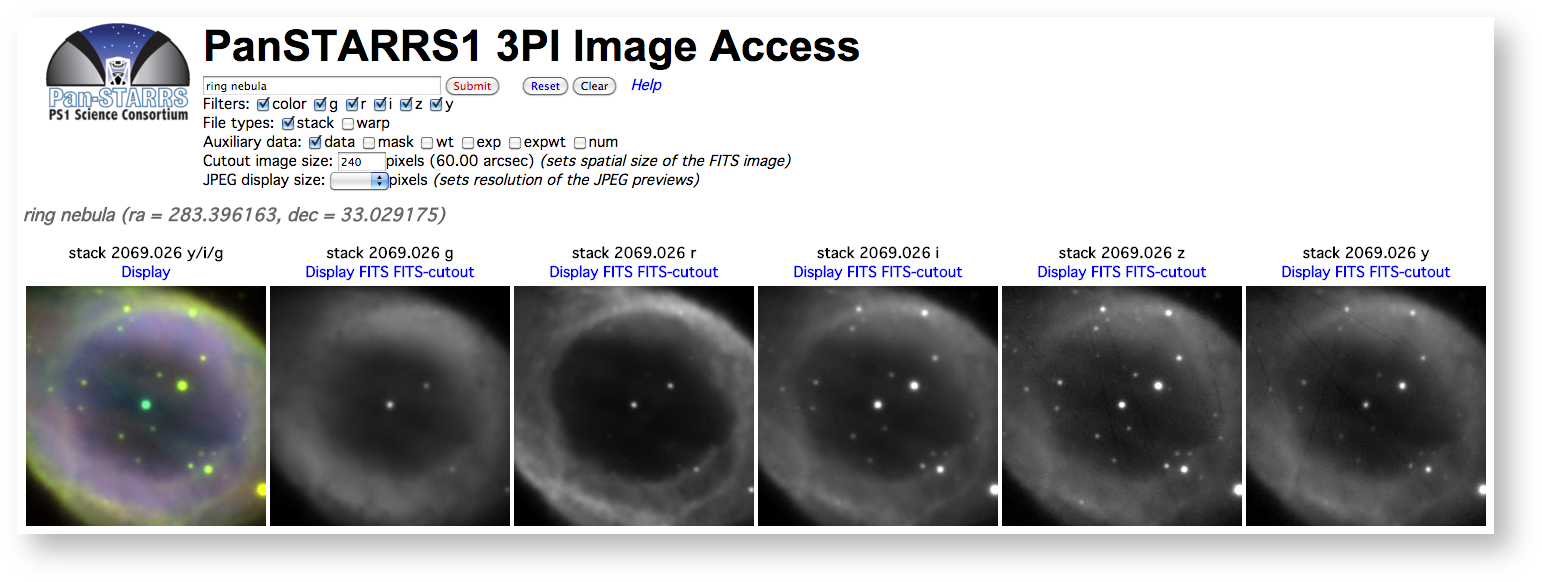
The search string can be a name that is recognized by NED or SIMBAD (e.g., "ring nebula" as above) or a position in various formats (RA and Dec in degrees, hh mm ss +dd mm ss, h:m:s d:m:s, etc.). A PanSTARRS image identifier (e.g., skycell.2069.026) is also accepted and is translated to the central position of that image.
The labels above each image identify the image type (stack or warp), the image identifier (these come from skycell.2069.026), and the filter. For warp images the labels also include the modified Julian date of the observations.
Changing the parameters
The default parameters for the search return 240x240 pixel cutout images (=1x1 arcmin for the PS1 scale of 0.25 arcsec/pixel), including a color image and all five filters, grizy. The filters used for the color image are the reddest (y), the bluest (g), and the middle image (i).
The parameters allow changing the defaults:
| Parameter | Description |
|---|---|
| Filters | Select a subset of the filters using check boxes |
| File types | Include the warp (single epoch) images in addition to or instead of the stack images |
| Cutout size | Specify the extracted image size in pixels. The conversion to arcsec is shown. If this size is large, the cutout image may reach the edge of the PS1 image; in that case the pixels off the edge are filled with blanks. |
| Output size | Select a fixed size for the display images. The cutout is scaled to the selected size. This can be used either to shrink the images when the cutout size is large or to expand the image for small cutouts. |
As an example, here are images for the Ring Nebula with the cutout size increased to 512 pixels (128 arcsec), the output size set to 256 pixels (so the JPEG scale is 0.5 arcsec/pixel), and the gri filters selected (which changes the color image as well):

Warp (single epoch) images
If the warp box is checked, the results include all single-epoch PS1 images that overlap the requested sky position. Here is an example for the Ring Nebula g-band images:
The result page shows the stack image(s) followed by all the warp images. The warps are grouped by filter (grizy) and are sorted by epoch of observation. Note that the individual warps often show many regions of missing pixels due to gaps between detectors, bad pixel regions, etc. These bad pixels are rejected during stacking, and the warp pointing centers are dithered so that the final quality of the stack images is generally very good. Obviously users will need to take care in using the single-epoch images!
There are usually a large number (~20) of warp images for each filter. Some of the warp images are completely blank because the actual sky coverage for the exposure does overlap the large skycell image but does not necessarily cover the cutout image region. Currently our PS1 image database does not have a detailed map of the precise sky coverage for individual exposures, so the warp images that lack sky coverage in a region are not known before the cutout is extracted. That will be improved in future versions of the interface.
Access to FITS images
In addition to the titles that identify the cutouts, there are links above the images. Here is the result for NGC 7222:
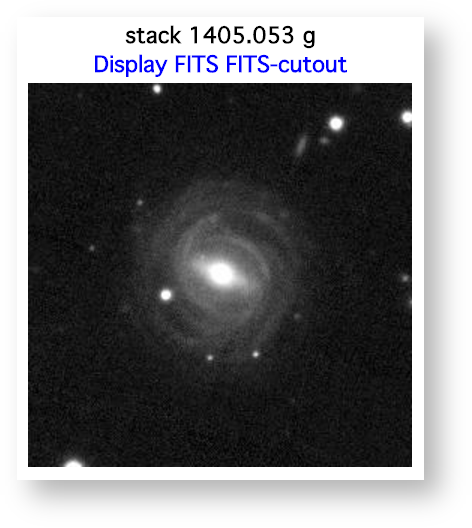
The FITS link downloads the full skycell image for this field. In this example that is a 6240x6243 pixel image (~0.43 degrees across) of the g filter stack for skycell 1405.053. Note that these images are compressed using the FITS tile-compressed image convention. The format can be read by most FITS libraries or can be converted back to a standard uncompressed FITS image using the ftools package.
The FITS-cutout link downloads a FITS image of only the cutout region. Note that these images have not been rebinned to the output size – they have the full resolution of the original images. FITS cutout images are not compressed.
The FITS links are not available for color images. Since the various filter images for a skycell are matched pixel by pixel, the individual FITS and FITS-cutout filter images can be downloaded separately and assembled into multi-band FITS images if desired.
Interactive image display
The Display link opens an interactive FITS image viewer that allows browsing the skycell image. The interactive viewer (adapted from the version originally developed for the Hubble Legacy Archive) allows the panning, zooming and changing the image contrast. It is also possible to overlay external catalogs such as SDSS and 2MASS on the image. There is a Help page that describes the standard functionality of this tool. Here is a screenshot of the display in the vicinity of NGC 7222:
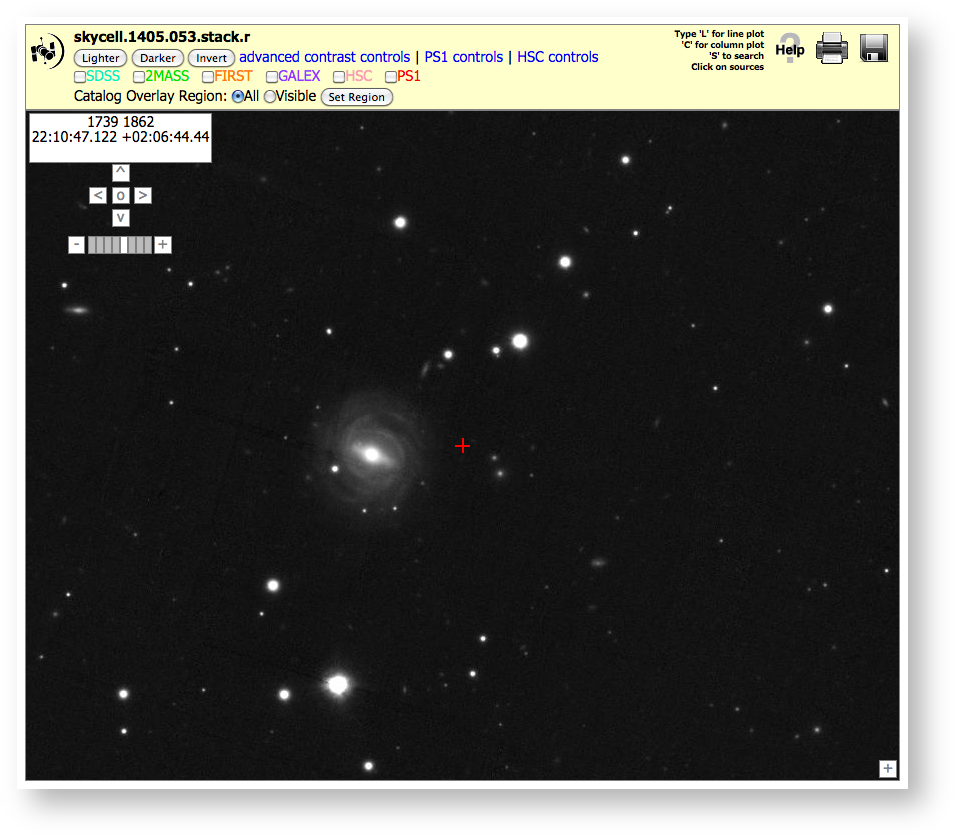
The Display link is also available for color images. Note that the compressed storage format of the FITS image makes the interactive display somewhat sluggish, especially for the color images (which are reading FITS images for all 3 filters being used). Options are being explored to improve the performance (which is currently tolerable if not ideal).
There is one custom catalog available for the PS1 image display: the PS1 checkbox overlays objects from the PanSTARRS catalog. Currently sources are shown from the PanSTARRS selected area, which covers about 70 square degrees in the sky region:
- 330o < RA < 338o (22h < RA < 22h 32m)
- -4o < Dec < +4o
When the final catalog is complete, sources from the entire 3PI survey area (Dec > -30o) will be available.
When catalogs are overlaid on the image, you can click on individual sources to see magnitudes and other properties.
Additional options for the PS1 catalog are available by clicking on PS1 controls. Currently the only option is to filter the catalog using the number of filters & epochs at which objects were detected. That is useful for filtering out single-epoch detections, which are often spurious. The default is nDetections>2, which produces a clean catalog but omits some faint objects.
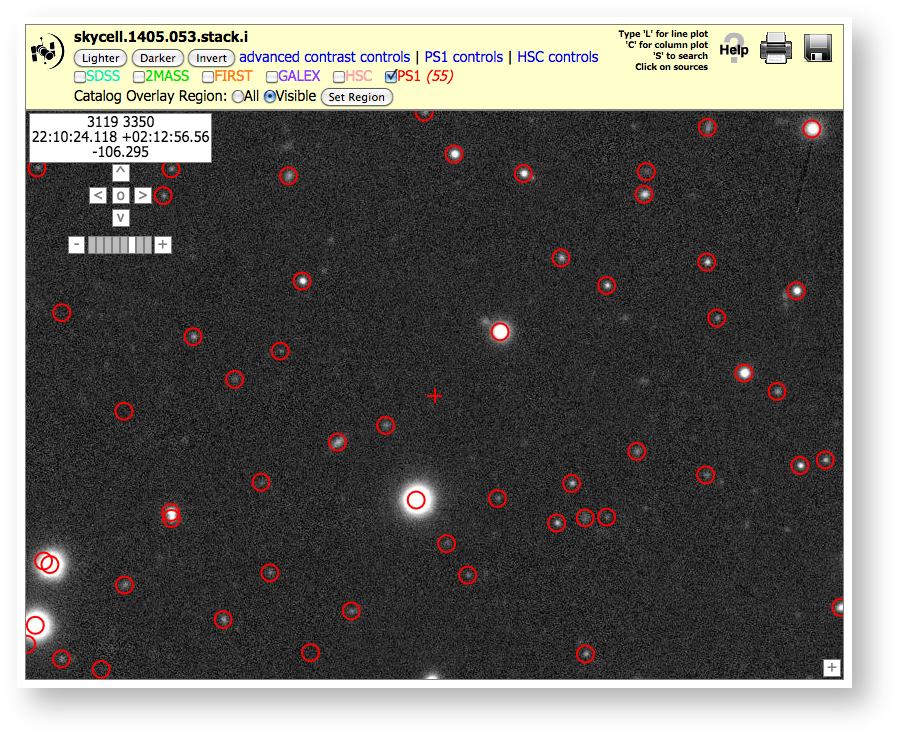
Scripted extraction of cutouts
This section will describe how to extract images using a script. An example Python script will be shown that finds and downloads FITS cutout images.
Plans for future additions & improvements
We plan to make a number of improvements and additions to this interface in the future. Suggestions for other additions are also welcome (send to archive@stsci.edu).
- Fill in blank pixels from neighboring skycells so that larger image cutouts are possible.
- Give user the ability to select which filters are used to create the color image.
- Give user the ability to adjust the contrast in the cutout images.
- Provide an interface with easy access to corresponding cutouts from all the other associated images (weights, data quality images, etc.)
- Include more accurate footprints for the warp sky coverage in the database so that blank warp cutouts are rare.
- Speed up the interactive display and access to image cutouts either by recompressing the FITS skycell images to use blocks or by caching uncompressed versions of recently accessed images. Currently the images are compressed row by row, which is inefficient for access to randomly located blocks of pixels.
 Image Removed
Image Removed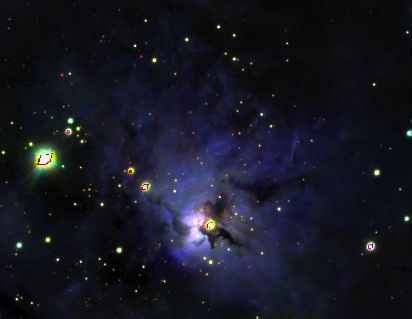 Image Added
Image Added
Color 256x256 arcsec 6.9x5.3 arcmin image of M8 using the PS1 gri riz filters created using the image cutout interface.
| Align | ||||
|---|---|---|---|---|
| ||||
| ||||
